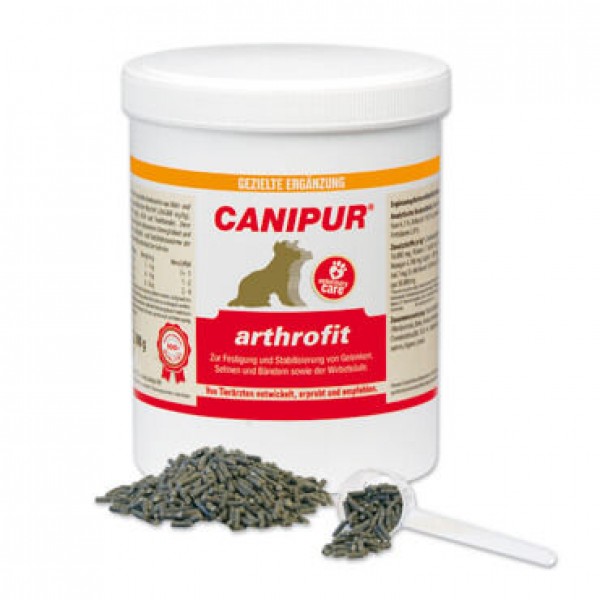Εφαρμογή
Το CANIPUR - arthrofit περιέχει έναν ειδικό συνδυασμό θρεπτικών συστατικών και ενεργών συστατικών (πράσινο μύδι Νέας Ζηλανδίας (200.000 mg/kg), θειική χονδροϊτίνη (100.000 mg/kg),
γλυκοζαμίνη, υαλουρονικό οξύ, MSM και νύχι του διαβόλου).
Εκτός από τη βελτίωση της γενικής κινητικότητας και απόδοσης, αυξάνουν επίσης την ελαστικότητα και τη σταθερότητα
της σπονδυλικής στήλης και αυξημένη ανθεκτικότητα των αρθρώσεων.
Αναλυτικά στοιχεία
Ακατέργαστη πρωτεΐνη: 21,7%
Ακατέργαστο λίπος: 7,6%
Ακατέργαστες ίνες: 4,6%
Ακατέργαστη τέφρα: 18,0%
Θείο: 2,6%
Νάτριο: 1,1%
Ωμέγα-3 λιπαρά οξέα: 2,8%
Πρόσθετα ανά kg: Διατροφικά πρόσθετα
Βιταμίνη C: 16.000 mg
Βιταμίνη Ε: 16.000 mg
Σίδηρος: 8.300 mg
Ψευδάργυρος: 8.300 mg
Μαγγάνιο: 6.700 mg
Χαλκός: 1.300 mg
Σελήνιο: 17 mg
Ιώδιο: 7 mg
L-Μεθειονίνη: 10.000 mg
Τεχνολογικά πρόσθετα:
Γη διατόμων: 30.000 mg
3b106 ένυδρο χηλικό αμινοξύ σιδήρου (II), ιωδιούχο κάλιο 3b201, ένυδρο χηλικό αμινοξύ χαλκού (II), ένυδρο χηλικό αμινοξύ μαγγανίου 3b504,
3b607 ένυδρη χηλική γλυκίνη ψευδάργυρου, μαγιά σεληνίου 3b812 από Saccharomyces cerevisiae CNCM I-3399 (αδρανοποιημένο).
Σύνθεση
Συμπύκνωμα μυδιών 20,0%, νύχι διαβόλου 15,0%, μείγμα βοτάνων (φλοιός ιτιάς, σημύδα, άρνικα, τσουκνίδα, χαμομήλι)
Θειική χονδροϊτίνη 10,0%, μεθυλοσουλφονυλομεθάνιο (MSM) 6,0%, γλυκοζαμίνη 5,0%, λιναρόσπορος, τζίντζερ, λινέλαιο, υαλουρονικό οξύ 0,4%.
Σημείωση: Περιέχει συμπύκνωμα μυδιών - δεν πρέπει να χορηγείται σε μηρυκαστικά.
Δοσολογία
Μικρά σκυλιά (4-15 κιλά) 1-4 g την ημέρα
Μέτρια σκυλιά (16-39 κιλά) 4-8 g την ημέρα
Μεγάλα σκυλιά (40-80 kg) 8-16 g την ημέρα
Μαζί με τη ζωοτροφή.
Η δόση μπορεί να μειωθεί στο μισό ως προληπτικό μέτρο.
Λόγω της καθοριστικής ποιότητας γεύσης των μυδιών, ταΐστε στην αρχή με μικρότερες μερίδες!
Λόγω της υψηλότερης περιεκτικότητας σε ιχνοστοιχεία, το ημερήσιο σιτηρέσιο δεν πρέπει να υπερδιπλασιάζεται.
Διάρκεια σίτισης
Για να επιτευχθεί το βέλτιστο αποτέλεσμα, η περίοδος σίτισης πρέπει να είναι τουλάχιστον 3 εβδομάδες.
Η σίτιση για μεγαλύτερο χρονικό διάστημα, ειδικά ως προληπτικό μέτρο, έχει νόημα και βελτιώνει τα αποτελέσματα.
Γενικά ευρήματα της διατροφικής επιστήμης
Στο μυοσκελετικό σύστημα του σκύλου, οι αρθρώσεις με τον χόνδρο τους και τον περιβάλλοντα συνδετικό ιστό καθώς και η σπονδυλική στήλη εκτίθενται σε ιδιαίτερα υψηλά φορτία.
Προκειμένου να ικανοποιηθούν αυτές οι απαιτήσεις και οι διαταραχές που προκαλούνται από υποσιτισμό, υπερβολική εργασία, ασθένειες (π.χ. οστεοαρθρίτιδα, δυσπλασία ισχίου, παράλυση dachshund)
ή για την πρόληψη της φυσικής διαδικασίας γήρανσης, ο οργανισμός θα πρέπει να εφοδιάζεται με έναν ειδικό συνδυασμό θρεπτικών συστατικών και ενεργών συστατικών,
που έχει προστατευτική και αναγεννητική λειτουργία στους ιστούς του μυοσκελετικού συστήματος.
Οι γλυκοζαμινογλυκάνες είναι ένα κύριο συστατικό του συνδετικού ιστού στον οποίο καλύπτονται οι τένοντες και τα έλυτρα των τενόντων,
ολόκληρους τους συνδέσμους, τις αρθρικές κάψουλες και τον χόνδρο, και το αρθρικό υγρό (αρθρικός υμένας).
Η βασική ουσία του συνδετικού ιστού με τις γλυκοζαμινογλυκάνες του είναι υπεύθυνη για τη μηχανική του ανθεκτικότητα,
από την άλλη, χρησιμεύει ως «μεταφορέας» θρεπτικών ουσιών και άχρηστων υλικών μεταξύ των κυττάρων του συνδετικού ιστού και της κυκλοφορίας του αίματος.
Σε περίπτωση μείωσης της συγκέντρωσης γλυκοζαμινογλυκάνης λόγω τραυματισμών, χρόνιων αλλαγών (π.χ. αρθροπάθεια, HD, παράλυση dachshund),
Με μεγάλα φορτία ή λόγω της φυσικής διαδικασίας γήρανσης, αυτές οι εργασίες δεν μπορούν πλέον να εκπληρωθούν.
Το αποτέλεσμα είναι η έλλειψη σταθερότητας και η μειωμένη ικανότητα αναγέννησης των αρθρώσεων, των χόνδρων, των συνδέσμων και των τενόντων.
Τα απαραίτητα λιπαρά οξέα όπως τα ωμέγα-3 λιπαρά οξέα μειώνουν την ευαισθησία σε φλεγμονές και αλλεργικές αντιδράσεις,
αύξηση της ελαστικότητας και της αντίστασης των αρθρώσεων, των συνδέσμων, των τενόντων και των μυών καθώς και ταχύτερη επούλωση σε περίπτωση παθολογικών αλλαγών.
Ο οργανισμός δεν μπορεί να δημιουργήσει ο ίδιος ακόρεστα, απαραίτητα λιπαρά οξέα, επομένως αυτά πρέπει να παρέχονται με την τροφή.
Η διτομική γη ενισχύει τον συνδετικό ιστό και αυξάνει την ελαστικότητα των τενόντων, των συνδέσμων, των τενόντων θηκών και των αρθρικών καψουλών.
Η βιταμίνη C και ο σίδηρος υποστηρίζουν το σχηματισμό κολλαγόνου.
Η βιταμίνη Ε και το σελήνιο διατηρούν τη σταθερότητα και τη σχισμή των ινών κολλαγόνου και βελτιστοποιούν το μεταβολισμό των μυών.
Βότανα όπως το νύχι του διαβόλου, το τζίντζερ, ο φλοιός ιτιάς, η σημύδα, η άρνικα, η τσουκνίδα ή το χαμομήλι ρυθμίζουν την
Οι δραστικές ουσίες που περιέχονται στα φυτά επηρεάζουν τον μεταβολισμό του συνδετικού ιστού και διακόπτουν τη φλεγμονώδη αλυσίδα.





